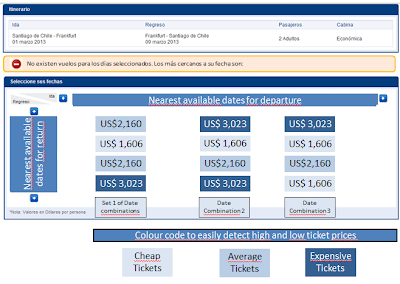It was a long
process, and the project is finally done. It wasn’t easy, oh no, it wasn’t.
This experience let us live the complexities of the generation of insight,
ideas and prototypes process as never before, with all their highs and lows.
Let see why.
First of all, there
was the problem definition, how we will approach it? From the previous days of
the semester, the observation phase was ready, we already knew a lot of things
so we put it everything written down in a whiteboard and realize that we were completely
lost: where to begin? Family travel, group travel, children, retired people,
which group should we design for? After doing a big mind map with every group
that came into our minds with their main characteristic we arrived nowhere. So
then we tried to use the reverse assumption technique, but, again, our
destination was nowhere. After that we sat down and begin to chat, looking all
the information on board, kind of depressed as we didn’t get anything useful…
although I don’t remember when we start talking about crazies travels that
people might want to do, like live the II world war, the storming of the
Bastille, live like an Amazon Indian or whatever, and we though: “Hey, this isn’t
a bad idea after all”. At this stage I remember how many time during classes we
heard that the good ideas came after all the obvious one had been exhausted,
just like this time.
With that on
mind, we draw a big timeline along the board, placed the idea where it belongs
and start to think on the other stages of the timeline, using the techniques we
feel comfortable, generating a good amount of ideas where we later selected the
one we thought would relate better with the initial idea and so we did and the
service took form.
But then it came
the stage as how we would make the video, and this was the hardest part,
because not only we had to agree on the idea, but how we would present it and
combine the different views and thing each one considered most important and it
was hell. We argue a lot, because, in the end, no one really knew how the video
was going to be, there was no global vision of it because we couldn’t agree on
that either. After hours of intense debates -
I think we could be on Tolerancia Cero
and perform just fine – we agreed on a few points and go home with the mood
on the floor.
After that, I
talked with my girlfriend and told me all the “ideal” steps that we should
follow to make a decent video, and realize that I knew one (screenplay) but
never heard of the others, and that this would have save us so much time. I
think the teaching team should have given us some guidelines as how to make
this video, as I have never opened an edition software neither recorded
anything. With all this new information, and also a couple of ideas of how to
record the video, I came the next meeting, agreeing much faster and we finally
start to move forward with a clear goal in our minds. We still had to discuss
of what things to say, in which order, what we’ll show, etc, but it was much
easier as now we have a common vision. Nevertheless, it was a slow process, and
here I realized how different things can go with the one in our minds, and that
one actually must built the prototype, video, or whatever it needs, to see if
it really works.
After all the
time spent in this project, I can see why the innovation process can be long – and
painful – and that in the end no matter how many techniques we use to generate
ideas, one must be able to present it in the right way so everyone understands
the same thing we thought in the first place.




